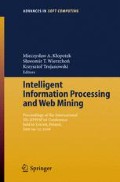Abstract
A set of 974 lexical symbols is defined which may appear in Polish text. Based on this set, a context-free grammar is constructed whose Chomsky normal form possesses 755 variables, 490 terminals and 1790 productions. Probabilities of these productions are estimated using over 40000 unparsed sentences. It turns out that a parsing algorithm using the resulting probabilistic context-free grammar parses correctly about 1/4 sentences.
Access this chapter
Tax calculation will be finalised at checkout
Purchases are for personal use only
Preview
Unable to display preview. Download preview PDF.
References
1. Bobrowski I. (1995) Gramatyka opisowa jêzyka polskiego (zarys modelu generatywno- transformacyjnego). Tom pierwszy: struktury wyjœciowe. Wy¿sza Szkola Pedagogiczna im. Jana Kochanowskiego, Kielce
2. Galus St. (2005) Dictionary-based part-of-speech tagging of Polish. In: Kłopotek M. A., Wierzchoñ S. T., Trojanowski K., editors, Intelligent Information Processing and Web Mining. Proceedings of the International IIS: IIPWM/05 Conference, pages 179 –188, Springer-Verlag, Berlin Heidelberg
3. Manning Ch. D., Schütze H. (1999) Foundations of Statistical Natural Language Processing. The MIT Press, Cambridge, Massachusetts, London, England
4. Marciniak M., Mykowiecka A., Kupœæ A., Wêgiel M. (2000) Klasy.kacja zjawisk syntaktycznych na potrzeby testowego zbioru wyra¿eñ jêzyka polskiego. Prace IPI PAN 908, IPI PAN, Warszawa
5. Vetulani Z. (2004) Komunikacja czlowieka z maszynæ. Komputerowe modelowanie kompetencji jêzykowej. Akademicka O.cyna Wydawnicza EXIT, Warszawa
Author information
Authors and Affiliations
Editor information
Editors and Affiliations
Rights and permissions
Copyright information
© 2006 Springer
About this paper
Cite this paper
Galus, S. (2006). Parsing Polish as a Context-Free Language. In: Kłopotek, M.A., Wierzchoń, S.T., Trojanowski, K. (eds) Intelligent Information Processing and Web Mining. Advances in Soft Computing, vol 35. Springer, Berlin, Heidelberg. https://doi.org/10.1007/3-540-33521-8_32
Download citation
DOI: https://doi.org/10.1007/3-540-33521-8_32
Publisher Name: Springer, Berlin, Heidelberg
Print ISBN: 978-3-540-33520-7
Online ISBN: 978-3-540-33521-4
eBook Packages: EngineeringEngineering (R0)

